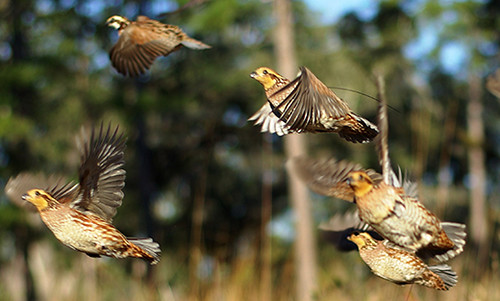
by Rick O'Connor | Dec 13, 2019
‘Bobwhites in Pine Savanna’ Workshop Set
For Jan. 30 in Marianna, Florida
The National Bobwhite Conservation Initiative (NBCI) and partners will host the Tri-State Bobwhite Symposium for professional land managers and landowners Thursday, January 30, 2020, in Marianna, FL.
It is the second Working Lands for Wildlife–Bobwhites in Pine Savanna workshop funded by the Natural Resources Conservation Service and is expected to draw attendees from three states. The program goal is to restore pine savanna on 82,000 acres across seven states using thinning, prescribed fire, and native grass restoration. Federal funding is available to landowners who choose to pursue pine savanna management on that designated landscape.
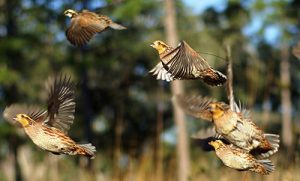
Bobwhite quail are popular with many hunters and management is trying to restore them.
Photo: USDA
“Private lands are a critical and necessary component for landscape-scale restoration of wild bobwhites, which is what NBCI is all about,” said NBCI Forestry Coordinator Steve Chapman. “Active management of pine forests on those lands, while still meeting landowner objectives, is a key NBCI strategy, and 82,000 managed acres will show the dividends of this approach.”
Dr. Jess McGuire, Quail Forever’s Working Lands for Wildlife bobwhite coordinator, added that “in order to achieve this level of restoration, wildlife professionals must be trained in the nuances of bobwhite management.”
The workshop will be from 9am–2pm at the University of Florida, Institute of Food and Agricultural Sciences (UF/IFAS) office, located at 2741 Penn Avenue, Suite 3, Marianna, FL 32448. Preregistration by January 23 is required by contacting jmcguire@quailforever.org or online at http://bit.ly/tristatequail.
Additional partners include Quail Forever, Florida Fish and Wildlife Conservation Commission, Tall Timbers Research Station and Land Conservancy, University of Florida Extension, and the Natural Resources Conservation Service.
Through multiple agreements, NBCI, in collaboration with Quail Forever and Warnell School of Forestry and Natural Resources/University of Georgia, will provide at least one of these workshops in each of the seven states identified in the project geography. Those states include Alabama, Florida, Georgia, New Jersey, North Carolina, South Carolina, and Virginia. Partners will also produce educational materials detailing management techniques and the results of intentional, targeted pine savanna management for bobwhites as part of the overall project.
About NBCI
Headquartered at the University of Tennessee’s Institute of Agriculture/Department of Forestry, Wildlife and Fisheries, NBCI is a science and habitat-based initiative of the National Bobwhite Technical Committee (NBTC) to elevate bobwhite quail recovery from an individual state-by-state proposition to a coordinated, range-wide leadership endeavor to restore wild bobwhites on a landscape scale. The committee is comprised of representatives of 25 state wildlife agencies, various academic research institutions and private conservation organizations. Support for NBCI is provided by the Federal Aid in Wildlife Restoration Program, state wildlife agencies, the Joe Crafton Family Endowment for Quail Initiatives, the University of Tennessee, Park Cities Quail and Roundstone Native Seed.
Contact:
John Doty
Communications Director
(865) 974-7281
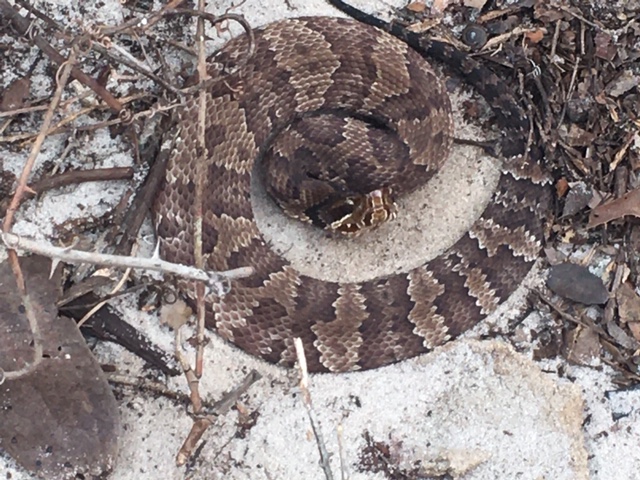
by Rick O'Connor | Nov 8, 2019
Over the last two years I have been surveying snakes in a local community on Perdido Key. The residents were concerned about the number of cottonmouths they were seeing and wanted some advice on how to handle the situation. Many are surprised by the number of cottonmouths living on barrier islands, we think of them as “swamp” residents. But they are here, along with several other species, some of which are venomous. Let’s look at some that have been reported over the years.
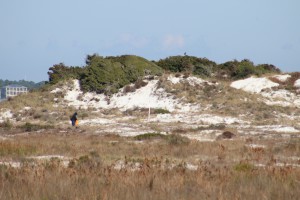
The dune fields of panhandle barrier islands are awesome – so reaching over 50 ft. in height. This one is near the Big Sabine hike (notice white PVC markers).
In the classic text Handbook of Reptiles and Amphibians of Florida; Part One – Snakes (published in 1981), Ray and Patricia Ashton mention nine species found on coastal dunes or marshes. They did not consider any of them common and listed the cottonmouth as rare – they seem to be more common today. In a more recent publication (Snakes of the Southeast, 2005) Whit Gibbons and Michael Dorcas echo what the Ashton’s published but did add a few more species, many of which I have found as well. Their list brings the total to 15 species. I have frequently seen four other species in Gulf Breeze and Big Lagoon State Park that neither publication included, but I will since they are close to the islands – this brings the total 19 species that residents could encounter.
Leading us off is the one most are concerned about – the Eastern Cottonmouth (Agkistrodon piscivorous). Though listed as “rare” by the Ashton’s, encounters on both Pensacola Beach and Perdido Key are becoming common. There is more than one subspecies of this snake – the eastern cottonmouth is the local one – and that the water moccasin and cottonmouth are one in the same snake. This snake can reach 74 inches in length (6ft). They are often confused with their cousin the copperhead (Agkistrodon contorix). Both begin life in a “copper” color phase and with a luminescent green-tipped tail. But at they grow, the cottonmouth becomes darker in color (sometimes becoming completely black) while the copperhead remains “copper”. The cottonmouth also has a “mask” across its eyes that the copperhead lacks. Believe it or not, the cottonmouth is not inclined to bite. When disturbed they will vibrate their tail, open their mouth showing the “cottonmouth” and displaying their fangs, and swiveling their head warning you to back off. Attacking, or chasing, rarely happens. I find them basking in the open in the mornings and seeking cover the rest of the day. Turning over boards (using a rake – do not use your hand) I find them coiled trying to hide. MOST of the ones I find are juveniles. These are opportunistic feeders – eating almost any animal but preferring fish. They hunt at night. Breeding takes place in spring and fall. The females give live birth in summer. As mentioned earlier, they seem to be becoming more common on our islands.
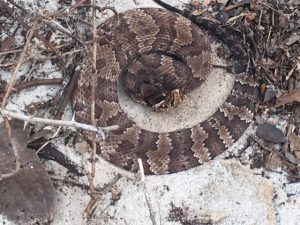
Eastern Cottonmouth with distinct “mask” and flattened body trying to intimidate.
Photo: Rick O’Connor
This year, while surveying for cottonmouths, I encountered numerous Eastern Coachwhips (Masticophis flagellum). These long slender snakes can reach lengths of 102” (8ft.), move very fast across the ground – often with their heads raised like a cobra – and, even though nonvenomous, will bite aggressively. They get their name from their coloration. They have a dark brown head and neck and a tan colored body – resemble an old coachwhip. They like dune environments and are excellent climbers. They consume lizards, small birds and mammals, and even other small snakes. They are most active during the daylight, but I usually find them beneath boards and other debris hiding. They have always been on the islands but encountered more often this past year. They lay eggs and do so in summer.
Their close cousin, the Southern Black Racer (Coluber constricta) is very similar but a beautiful dark black color. They can reach lengths of 70” (6ft.) and are also very fast. Like their cousin, they are nonvenomous but bite aggressively – often vibrating their tail like cottonmouths warning you to stay back. They are beneficial controlling amphibian, reptile, and mammalian animals. They are also summer egg layers.
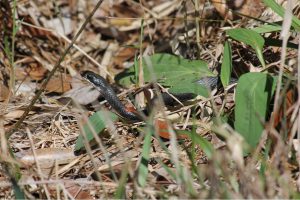
The southern black racer differs from otehr black snakes in its brillant white chin and thin sleek body.
Photo: Jacqui Berger.
There are a few freshwater snakes that, like the cottonmouth do not like saltwater, but could be found on the islands. These are in the genus Nerodia and are nonvenomous. There are two species (the Midland and Banded water snakes) that could be found here. They resemble cottonmouths in size and color and are often confused with them. They differ in that they have vertical dark stripes running across their jaws and have a round pupil. Though nonvenomous, they will bite aggressively. One member of the Nerodia group is the Gulf Coast Salt Marsh Snake (Nerodia clarkii clarkii). This snake does like saltwater and is found in the brackish salt marshes on the island. It is dark in color with four longitudinal stripes, two are yellow and two are a dull brown color. It only reaches a length of 36” (3ft.), is nocturnal, and feeds on estuarine fish and invertebrates.
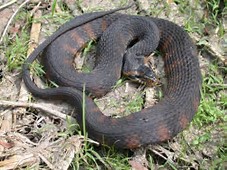
This banded water snake is often confused with the cottonmouth. This animal has the vertical stripes extending from the lower jaw, which is lacking in the cottonmouth.
Photo: University of Georgia
Other species that the guides mention, or I have seen, are the small Crowned Snake, Southern Hognose, Pine Snake, Pine Woods Snake, and the Rough Green Snake. I will mention here species I have seen in either Gulf Breeze or Big Lagoon State Park that COULD be found on the island: Eastern Coral Snake, Eastern Garter Snake, Pigmy Rattlesnake, Eastern Hognose, and the Corn Snake (also called the Red Rat Snake). Only two of these (Eastern Coral and Pigmy) are venomous.
Last, but not least, is the Eastern Diamondback Rattlesnake (Crotolus adamateus). This is the largest venomous snake in the United States, reaching 96” (8ft.). It is a diurnal hunter consuming primarily small mammals, though large ones can take rabbits. They prefer the dry areas of the island where cover is good. Palmettos, Pine trees, and along the edge of wetlands are their favorite haunts. Despite their preference for dry sandy environments, they – like all snakes – are good swimmers and large rattlesnakes have been seen swimming across Santa Rosa Sound and Big Lagoon. They tend to rattle before you get too close and you should yield to this animal. The have an impressive strike range, 33% of their body length, you should give these guys a wide berth. I have come across several that never rattled, I just happen to see them. Again, give them plenty of room when walking by.
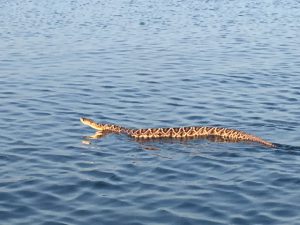
Eastern diamondback rattlesnake swimming in intracoastal waterway near Ft. McRee in Pensacola.
Photo: Sue Saffron
It is understandable that people are nervous about snakes being in popular vacation spots, but honestly… they really do not like to be around people. We are trouble for them and they know it. Most encounters are in the more natural areas of the islands. Staying on marked trails and open areas, where you can see them – and be sure to look down while walking, you should see them and avoid trouble. For more questions on local snakes, contact me at the county extension office.
References
Ashton, R.E., P.S. Ashton. 1981. Handbook of Reptiles and Amphibians of Florida; Part One – Snakes. Windward Publishing, Miami FL. Pp.176.
Gibbons, W., M. Dorcas. 2005. Snakes of the Southeast. University of Georgia Press, Athens GA. Pp. 253.
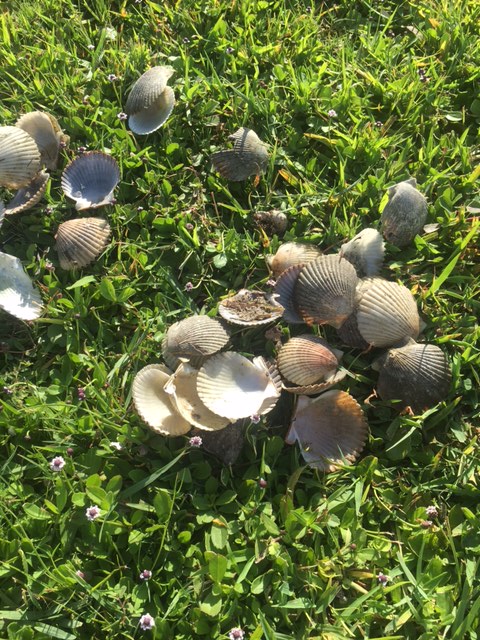
by Rick O'Connor | Sep 9, 2019
Many people enjoy scallops. Just as many enjoy scalloping.
It is a great Florida family activity where everyone gets to snorkel in relatively shallow – safe waters. You explore the grassbeds for a myriad of cool marine creatures yelling across the bay to friends about all the neat things you are seeing.
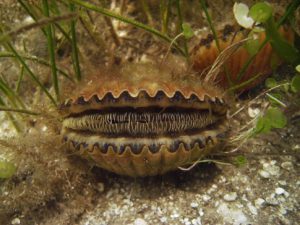
Bay Scallop Argopecten iradians
http://myfwc.com/fishing/saltwater/recreational/bay-scallops/
And of course, there are the scallops. Sitting on top of the grass blades with their undulated ridged shells and ice blue eyes. You reach to grab one and they begin the “clap” their shells together to escape being captured. You finish the adventurous day with your limit of scallops, and it is time to eat – broiled in butter and some seasoning is my favorite.
It is great fun. However, it is becoming harder to find them.
Once found in grassbeds from Pensacola to Miami, the recreational harvest has been restricted to the Big Bend area – the commercial no longer happens. Everywhere their numbers are down and many locations within their historic range, you cannot even find them. Since 2015, Florida Sea Grant has conducted scallop searches in the Pensacola Bay area using citizen volunteers and have found only one live animal. We have found numerous shells of these creatures, who only live a year… maybe two. We have had reports of live scallops in the bay area outside of our formal search dates, I have personally found some, but the numbers are still very low – low enough that recreational harvesting in the Pensacola Bay area is closed indefinitely.
The story is the same from south of the Big Bend. Scallop searches are conducted every year and returns are low, or non-existent. So, the focus turns the Big Bend.
They are famous for the scallop seasons. Floridians travel from all neighboring counties, and from across the state, to partake in this fun activity. It is good business for these local communities. For some, it is the biggest money maker of the year. However, now we are hearing stories of low harvest numbers in some parts of the Big Bend. In recent years, Port St. Joe Bay has suffered from algal blooms and red tide that not only closed the waters to harvesting for swimming safety reasons, but because the scallop numbers declined as well. One story out of Hernando County indicated that the numbers in this region are now down. You must consider overharvesting as a problem as well.
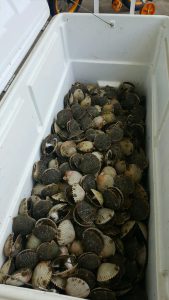
Prepared properly: One of the finest meals you will ever have.
FWC is interested in restoring these animals to parts of their range where they were once common. The Scallop Sitters program is one where volunteers can hang caged scallops raised in state hatcheries from their docks, protected from predators, and allow them to mass spawn. The first pilot project in our area was in Bay and Gulf counties… last year… when Hurricane Michael came through. Obviously, they will have to start over.
What is needed to extend this project into other bay areas?
Well, you certainly do not want to put them into waters where you know they will die. The scallop populations declined for a reason – primarily habitat loss and overharvesting. Excessive stormwater runoff decreased much needed salinity and increased grass killing turbidity. Loss of seagrass equates to loss of scallops. Florida Sea Grant is currently working with the University of West Florida, and citizen volunteers, to monitor seagrass growth and density in Santa Rosa Sound and Big Lagoon. We will have a report on this year’s work later this fall. We are also working with citizen scientists monitoring salinity in these bodies of water hoping for a mean of 20 parts per thousand or better. We will have the summer salinity reports out at the end of September. We hope these data will support the argument of extending the scallop sitters program further west.
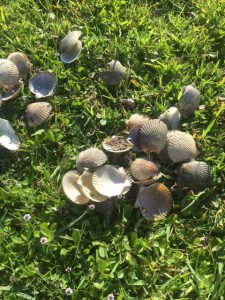
A pile of cleaned scallops found in a parking lot on Pensacola Bay. harvesting scallop in Pensacola Bay is illegal.
Photo: Rick O’Connor
But there is the question of overharvesting.
In recent years we have found evidence of locals in the Pensacola Bay area illegally harvesting the few scallops we have. Some residents do not know that it is illegal to harvest in these waters – it is – and the only way we can successfully restore them, is allow them to mass spawn. To do this, we need large numbers.
Each year Florida Sea Grant conducts the Great Scallop Search in the Pensacola Bay area. We also host a “Bio-Scavenger Hunt” in the fall where scallops are one of the target species. If you are interested in volunteering, contact Rick O’Connor at the Escambia County Extension Office – (850) 475-5230 ext. 111, or roc1@ufl.edu.
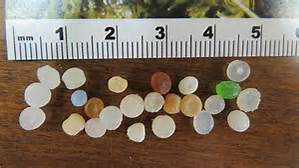
by Rick O'Connor | Sep 6, 2019
It is an amazing product actually… plastic. It can be molded into all sorts of shapes and forms. In some cases, it can be more durable than other products, it is lighter and cheaper than many. Slowly over time, we began to use more and more of it. I remember as a kid in the ‘60s Tupperware products were common. Cups and bowls with resealable lids. Coffee cups followed, then 2-Liter coke bottles, to the common water bottle we see today. As I look around the room, I am in right now there are plastic pens, picture frames, suntan lotion bottles, power cords, rain jacket, the cover and keyboard of this laptop. Plastic is part of our lives.
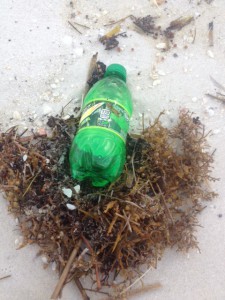
A variety of plastics ends up in the Gulf. Each is a potential problem for marine life. Photo: Rick O’Connor
Unfortunately, being relatively inexpensive, it is also easily disposed of. Many forms of plastic are one-time use. In some cases, we purchase and discard them without really using them – plastic wrap covering fruit, or the famous plastic grocery bags. Most of this discarded plastic eventually finds its way into the environment. Data from the 2017 International Coastal Clean Up, showed that globally all the top 10 items collected were plastic. Most of it was cigarette butts and items related to food and drink. Even with all the press, the number of plastic grocery bags collected actually increased. One study conducted in 2015 estimated the amount of plastic in our oceans would be enough to fill 5 plastic grocery bags for each foot of shoreline of the 192 countries they surveyed.
There is a lot of plastic out there. One researcher commented… it’s all still there. Some have estimated that plastic takes about 600 years to completely break down. Plastic items degrade while exposed to sun, sand, and saltwater. But they never go away. They become smaller and smaller to a point where you cannot even see them anymore – these are called MICROPLASTICS.
Microplastics are defined as any plastic items 5mm or smaller in diameter. Most plastics float, and most microplastics float as well, but pieces of microplastics have been found throughout the water column and even in the deep-sea sediments. They come in two forms; primary and secondary.

“Nurdle” are primary microplastics that are produced to stuff toys and can be melt down to produce other products.
Photo: Maia McGuire
Primary microplastics are plastics that are produced at these small sizes. All plastic products begin as small beads called nurdles. Nurdles are produced and shipped to manufacturing centers where they are melted down and placed into forms which produce car bumpers, notebook covers, and water bottles. Many of these nurdles are shipped via containers and spills occur. Other primary microplastics are microbeads. These are used in shampoo, toothpaste, and other products to make them sparkle, or add color. As they are washed down our sinks and showers, they eventually make their way into the environment. Sewage treatment facilities are designed to remove them.
Secondary microplastics are those they were originally macroplastics and have been broken down by the elements. Plastic fragments and fibers are two of the more common forms of secondary microplastics. These micro-fibers make up 70-80% of the microplastics volunteers find in Florida waters. Many of these fibers come from our clothing, from cigarette butts, and other sources.
Are these microplastics causing a problem?
It is hard to say whether they have caused the decline in populations of any group of marine organisms, but we do know they are absorbing them. Studies have found microscopic plankton have ingested them, and some have ceased to feed until they pass them, if they do pass them. There has been concerned with the leaching of certain products in plastic to make them more flexible in bottled water. These products have been found in both plankton and in whales.
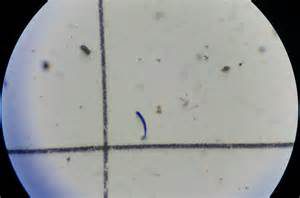
The most common form of microplastic are fibers.
Photo: UF IFAS St. Johns County
Another problem are the toxic compounds already in seawater. Compounds such as PCBs, PAHs, and DDT. It has been found that these compounds adhere to microplastics. Thus, if marine organisms consume (or accidentally ingest) these microplastics, the concentrations of these toxins are higher than they would be if the microplastics were not present.
Studies have shown:
– Pacific oysters had decreased egg production and sperm motility, fewer larvae survived, and the survivors grew more slowly than those in the control population.
– Plastic leachate impaired development of brown mussel larvae.
– Shore crabs fed microplastics consumed less food over time.
A recent summer research project at the University of West Florida found microplastics within the gut and tissues of all seafood products purchased in local seafood markets. And recently a study of human stool samples from volunteers in Europe and Japan found microplastics in us. Again, we are not sure of the impact on our health from this, but they are there.
So, what do we do?
One idea is to remove these microplastics from the ocean – skimming or filtering somehow. As you might guess, this also removes much needed phytoplankton and zooplankton.
There is the ole “Recycle, Reuse, Reduce” idea we learned when we were in school. Unfortunately, recycling plastic has not been working well. Being a petroleum product, the price of oil can dictate the price of recycled plastic. With low oil prices comes low recycling profits. In many cases it can be cheaper to produce and purchase new plastic products. Also, unlike glass, plastic can only be recycled so many times.
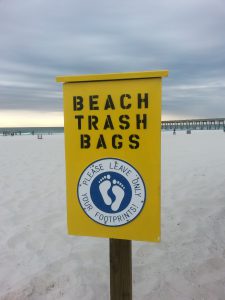
Boxes providing garbage bags and disposal.
Photo: Pensacola Beach Advocates
Reuse and reduce may be the better options. If you must purchase plastic items, try to reuse them. In many cases this is difficult and the reduce method is the better option. Reduce the purchase of plastic items such as your own drinking container instead of using the one-time plastic cup at meetings or events. And of course, reusable grocery bags. You will have to think on how to reduce some items, but most can be done.
There are numerous more suggestions, and more information, on Dr. Maia McGuire’s Flagler County Extension website – http://sfyl.ifas.ufl.edu/flagler/marine-and-coastal/microplastics/.
Help make others more aware of microplastics during Microplastics Awareness Month.
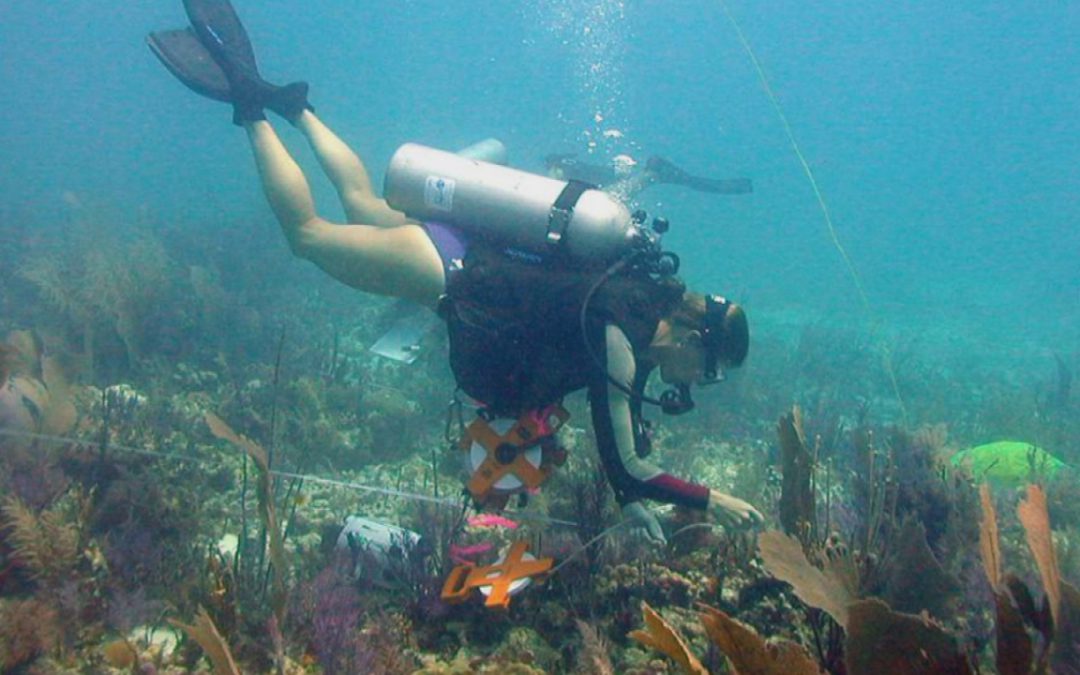
by Rick O'Connor | Aug 27, 2019
We like to post articles about fun and adventurous activities people can do outdoors in the Florida panhandle… but it is very hot out there this time of year. What sort of outdoor adventure can you have when the temperatures are running in the 90s and the humidity in the 80% range?
Water…
Many of us have our favorite swimming holes – local rivers, springs, estuaries, or the Gulf itself, but what about SCUBA? I recently talked to a local dive charter and they said the current weather pattern is not a problem for them. The seas are relatively calm – easy to get offshore, you are underwater – so not so hot, and afternoon rains washes the gear off. Sounds like a good adventure on a hot summer day.
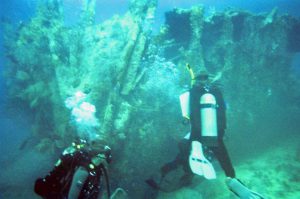
Diving near large coral.
Photo: Indiana University
But SCUBA is not for everyone. My wife tried and did not care for it. It certainly makes some folks nervous. Underwater seems confining to many. There is a lot of equipment you have to wear, and that can be bothersome. There are creatures out there, some of them rather large. And then there is the risk, many see SCUBA as a dangerous activity – and it can be. This is why they require a course for certification… to address all of these issues.
During the course they will put you in a swimming pool with the gear and see how comfortable you are. Honestly, I remember the first time I tried the tank. My brain was telling me “DO NOT INHALE… YOU ARE NOT A FISH”. But eventually I did, and MAN was that cool. As you become more comfortable you can swim some. All of this is done at the shallow end so if it is not working for you – you are fine. The equipment really is not that cumbersome while in the water. Swimming slow laps, getting use the breathing on the equipment, clearing your mask if water gets in, they teach you everything you need to know to be relaxed while underwater.
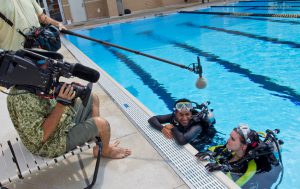
Student and instructor practice SCUBA skills in a swimming pool.
Photo: University of Central Florida.
There are skills you will need to learn while in the pool, and then the there is the classroom sessions. Much of it deals with the danger issue of diving – what could go wrong. As Jacques Cousteau once said, it is not going down that is the problem, it is coming back. We are all aware of the pressure changes that occur as you descend into the ocean. There is air pressure on your body at sea level – about 15 p.s.i. We do not notice this because our body compensates for it. However, as you descend into the water the pressure increases 15 p.s.i. every 33 feet you descend. You will feel this and are taught how to compensate for it. Once on the bottom, you will find all sorts of structures, fish, sometimes even sea turtles. You swim around trying to take it all in, but the entire you are down the pressure is pushing gases into your body. When it is time to return, you must do this the correct way – “gas off” as they say. Again, local instructors will explain all of this in class and you will have a chance to practice in the pool.
Then there is the open water dive.
You get a chance to test your skills in the open Gulf.
Again, this makes some a bit nervous. It is one thing in the safety of a swimming pool. It is another in the wild blue. There are jellyfish, fish, bigger fish, waves, can’t see the bottom yet, pirates, who knows what is running through your mind. But you are with friends. Everyone is going through the same experience and you have master divers at your side. It is all good. You eventually reach the bottom and see a world that is truly amazing.
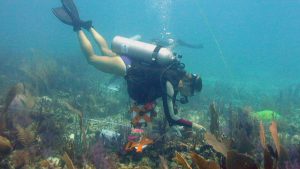
A diver explores a coral reef.
Photo: NOAA
Again, SCUBA is not for everyone, but it is a fun activity on these hot summer days. Something to consider trying. There are many great dive instructors along the Florida panhandle, and one near you. If SCUBA is too much – consider snorkeling, it can be a rewarding activity as well.
Stay cool.




















